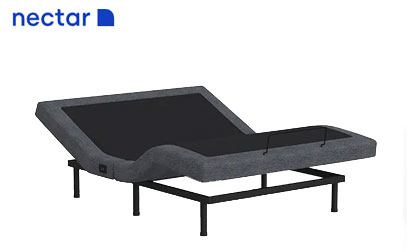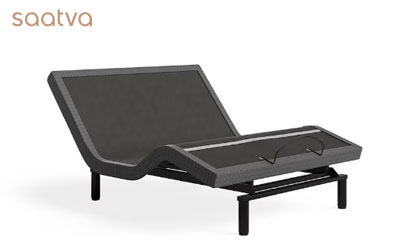While we might not have the technology to sleep in a real zero-gravity chamber yet, changing your sleeping posture to the zero-gravity position with an adjustable bed could be an excellent place to start in correcting a variety of sleep issues.
First popularized by NASA as a low-pressure position for astronauts to assume during take-off, the zero-gravity sleep position could help you rest easier by alleviating discomfort or other sleep-related problems. Better yet, the only tools you’ll need are an adjustable bed frame and a flexible mattress.
Read on to learn how to sleep in zero gravity on an adjustable bed and why this position could benefit your sleep quality.
Best Mattress for an Adjustable Bed
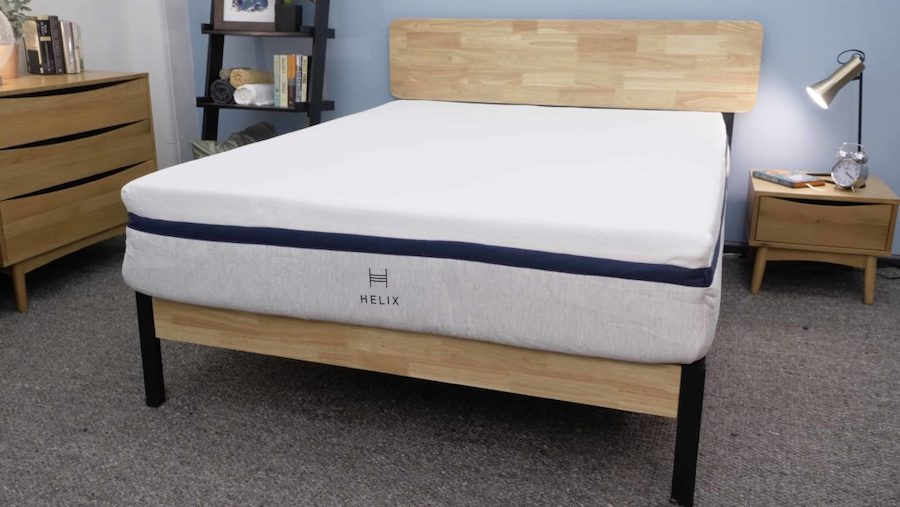
Helix Midnight Mattress
Part of Helix’s core line of mattresses, the Midnight has a hybrid construction that’s particularly suited to back and side sleepers.
Best Smart Bed
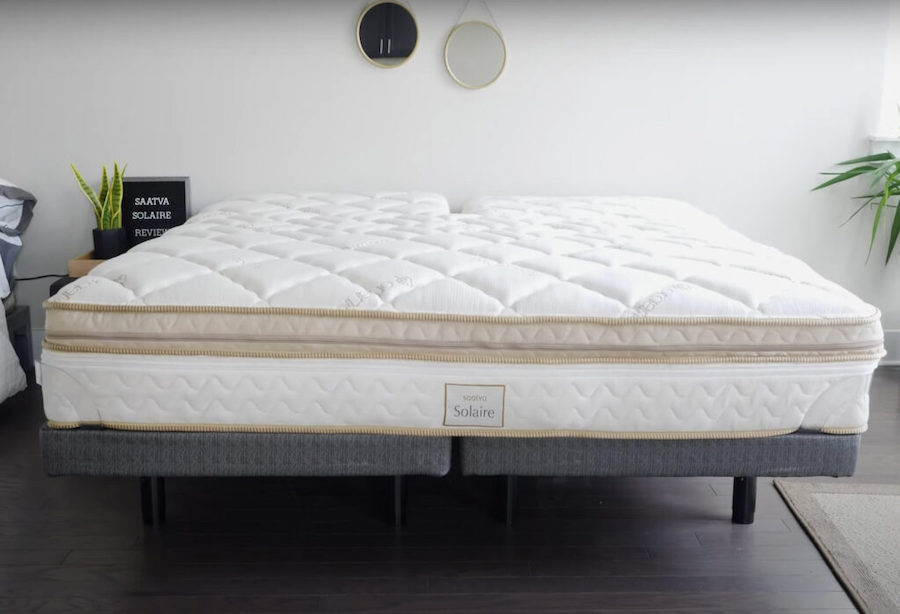
Saatva Solaire Mattress
Zoned latex foam in the Saatva Solaire allows sleepers up to 50 customizations, making it easy to adjust the firmness so that it fits most sleeping positions.
What Is the Zero-Gravity Sleep Position?
The zero-gravity position is a neutral sleeping posture1 originally developed by NASA. Its purpose was to reduce pressure on the bodies of astronauts during take-off.
When it comes to sleep, the concept is similar; lying in zero gravity may alleviate pressure to help people feel more comfortable while in bed. When you sleep in the zero-gravity position, your upper body and legs sit above your heart and stomach. Meanwhile, your knees stay slightly bent and extended to keep your lower legs parallel to your abdomen.
How Zero Gravity Affects the Human Body
While this position doesn’t literally make you float or eliminate gravity, it does give your body a weightless feeling that may make it easier to fall asleep, especially if you experience chronic sleep issues like sleep apnea or back pain.
The zero-gravity position can affect your body in several ways:
- Alleviates pressure on the spine
- Keeps your spine in a neutral position
- Evenly distributes your weight
- Improves breathing and blood flow
We’ll discuss the potential benefits of this sleeping position more thoroughly below. However, for now, you should know that the zero-gravity position can optimize your body posture for sleep, which may improve your sleep quality and reduce some sleep-related issues.
How to Adjust Your Bed to the Zero-Gravity Position
Before you can bend your mattress into a zero-gravity position, you’ll need to purchase a high quality adjustable bed frame and a good mattress for an adjustable bed.
Some bed frames have a zero-gravity preset that takes all of the guesswork out of adjusting your bed to this position. If you’re in the market for an adjustable base, we recommend choosing this type to save you time and ensure that you maintain the proper angles for zero-gravity sleeping.
However, you can also set an adjustable bed frame to the zero-gravity position manually. Here’s how:
1. Consult NASA’s Zero-Gravity Calculations
NASA originally developed the zero-gravity position to support astronaut health during space flight.1 Today, we can utilize this method to achieve the zero-gravity posture.
Based on this criteria, you will need to adjust your bed to create approximately a 128-degree angle between your torso and knees and around a 133-degree angle between your upper and lower legs to achieve a neutral body posture.
2. Set the Upper Body Incline
Now that you know NASA’s zero-gravity position calculations, you can adjust your bed to reflect the appropriate angles. Your first step will be to set the upper body incline of your mattress.
While your upper body can be vertical or horizontal to achieve this neutral body posture, we recommend adjusting the upper body incline on your mattress to around 30 degrees. This adjustment will elevate your upper body slightly while keeping you in a relaxed posture.
More: Best Smart Bed
3. Raise the Legs
Next, you will need to raise the leg incline of the bed frame slightly to create a 128-degree angle between your torso and thighs. If your bed frame does not show you the angles of your adjustments, you can always use a protractor to ensure that this bend is approximately 128 degrees.
Then, you will need to bend the lower portion of the frame to create around a 133-degree angle for your knees. Some people’s preferred angle may vary depending on their body type.
4. Save the Position
If your bed frame is programmable, you may be able to save the position you’ve created as a preset, allowing you to switch to this position instantly anytime you need to.
However, if your bed frame is not programmable, we recommend writing down these measurements and placing them on your bedside table. You can even draw a rough diagram of the positioning to spark your memory the next time you need to adjust your bed.
How to Sleep in the Zero-Gravity Position
Once you’ve adjusted your bed frame to reflect the neutral positioning angles from NASA, you will simply need to lie down with your back touching the middle portion of the mattress. Then, you can shift positions slightly to ensure that the two bends occur between your torso and thighs and at your knees.
If you’re naturally a side sleeper, you can also try sleeping on your zero-gravity bed while remaining on your side. However, we do not recommend this position for stomach sleepers, as it could contort your spine and create neck and back pain.
If you plan to sleep in the zero-gravity position long-term, we recommend purchasing a mattress for adjustable beds. Unfortunately, most mattresses do not have the necessary structure and support to twist into these angles. Placing the wrong kind of mattress on an adjustable frame could limit the mattress’ support and impact its durability.
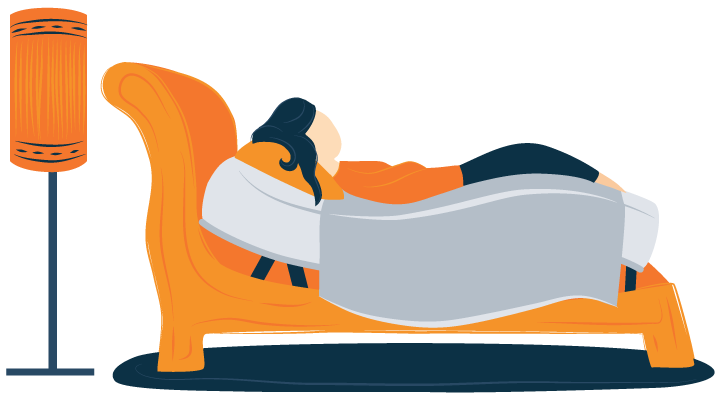
Our Favorite Adjustable Bed Frames to Help Achieve Zero-Gravity:
Nectar Adjustable Base
The Nectar Adjustable Bed Frame has a wireless remote, tool-free assembly, and an anti-snore setting.
Nectar Score
4.70 / 5
Saatva Adjustable Base Plus
The Saatva Adjustable Base Plus has almost every base covered (pun intended) with its array of features, including under-bed lighting, adjustable legs, and more.
Saatva Score
5.00 / 5
Benefits of a Zero-Gravity Bed
Sleeping on a bed frame adjusted to the zero-gravity sleeping position can be beneficial for several reasons. We’ll break these down in detail below, but it’s also important to check with your healthcare provider if you are having trouble sleeping due to other underlying issues.
Here are a few benefits of sleeping on a zero-gravity bed.
Less Snoring and Easier Breathing
As it turns, out sleeping on an incline in the zero-gravity posture may reduce snoring if that’s a frequent problem for you. In a research study of over 1,000 nights of data, sleeping on an incline was associated with a 7-percent drop in snoring duration2. So, what was the possible reason for the drop? According to research experts, keeping the torso at an incline opens up the airways more, allowing for easier breathing.2
Related: Best Mattress for Snoring
Heartburn and Acid Reflux
Another benefit of sleeping with the torso at an incline? It may help with heartburn and acid reflux3.
Heartburn and acid reflux tend to worsen when you lie down, as a horizontal position allows your stomach acid to rise into your esophagus. As such, sleeping in the elevated zero-gravity position could utilize gravity to keep the acid down and reduce nighttime heartburn and acid reflux that may otherwise keep you up.3
Less Insomnia and Deeper Sleep
The zero-gravity sleep position may help to relieve pressure throughout your body and distribute your weight more evenly, all of which can contribute to a more comfortable sleeping position. As a result, you may find that lying in this position reduces insomnia and helps you fall asleep faster and sleep more peacefully.
Improve Circulation
Elevating your legs at or above your heart can improve blood circulation4 throughout your body. This can be especially helpful if you frequently experience swollen feet or ankles5.
Get More Info: Sleeping With Legs Elevated
Support Digestion
Sleeping with your upper body slightly elevated can aid digestion, as food naturally travels downward throughout your digestive system. The zero-gravity sleeping position can allow gravity to assist this process as it does when you are sitting up or standing.
Read More: Benefits of Sleeping with Head Elevated
May Help With Back Pain
The zero gravity position can help with back pain6 in two ways. First, it can potentially ease pressure on the spine itself. Second, it could ease tension in the lower back muscles. As such, some researchers consider it an effective option for those with back pain.6
That said, there isn’t much new research about the effects of zero gravity position on back pain.
Frequently Asked Questions
What is the most natural sleeping position in zero gravity?
The most natural posture for assuming the zero-gravity position is on your back or your side. Conversely, stomach sleepers should avoid trying the zero gravity position since they would hyperextend their back and likely be more uncomfortable.
Is it safe to sleep in the zero-gravity sleep position?
Yes, it is safe to sleep in the zero-gravity sleep position, permitted you’re only trying it on your side or back and are using the appropriate incline angles for optimal comfort and spine alignment. We do not recommend doing this if you’re a stomach sleeper. Before trying this sleep position, talk to your healthcare provider. Some medical conditions may prevent you from sleeping this way.
Is the zero-gravity position good for back pain?
Your spine isn’t naturally straight and rigid — instead, it takes on a sort of “S” shape when viewed from the side. As a result, it makes sense that sleeping flat on your back could create back pain, as this position places excessive pressure on your spine by forcing it into a straight, flat position.
However, sleeping on your back in the zero-gravity position can allow your spine to maintain this “S” shape, relieving stress from your back and promoting a more natural alignment. If you experience back pain, you may find some relief by switching to a zero-gravity bed. Again, before trying new sleep positions, speak with your healthcare provider about their recommendations.
Learn More: Best Mattresses for Back Pain on a Budget
Do you use a pillow in the zero-gravity position?
While you can use a pillow in a zero-gravity sleeping position, doing so could alter the precise angles of this positioning, limiting its benefits for your neck and spine. If you prefer to use a pillow on a zero-gravity bed, we recommend choosing a flat one to reduce its impact on your alignment.
Can an adjustable bed cause hip pain?
Sleeping in a zero-gravity bed should keep your hip joints slightly bent throughout the night, and many people may wonder whether this position could create hip pain. While most people may not experience hip pain, this isn’t the case for everyone, which is why we emphasize talking with your healthcare provider before trying it out.
Learn More: Best Mattress for Hip Pain and Best Mattress for Arthritis
Final Word of Advice
If you have chronic sleep problems, choosing the perfect mattress may not be enough to help you achieve a deep sleep night after night. Instead, you may need an even more innovative solution, such as adjusting your bed to the zero-gravity position.
If you’re still unsure whether this position is suitable for you, we recommend talking to your healthcare provider first. If they say it’s okay, then purchasing an affordable adjustable bed frame and sleeping in the zero-gravity position for a few weeks. You may be surprised by how well-rested and pain-free you feel in the mornings after sleeping in this unique position.

Jill Zwarensteyn
Senior Editor
About Author
Jill Zwarensteyn is the senior editor for Sleep Advisor and a certified sleep science coach. She is enthusiastic about providing helpful and engaging information on all things sleep and wellness.
Combination Sleeper
Education & Credentials
- Certified Sleep Science Coach
References:
- “Neutral Body Posture Specifications”. NASA. 2016.
- Danoff-Burg PhD, Sharon., et al. “Sleeping in an Inclined Position to Reduce Snoring and Improve Sleep: In-home Product Intervention Study”. JMIR Formative Research. 2022.
- Albarqouni, Loai., et al. “Head of bed elevation to relieve gastroesophageal reflux symptoms: a systematic review”. BMC Family Practice. 2021.
- Lelapi, Nicola., et al. “Elevate to Alleviate – Evidence Based Vascular Nursing Study”. Nursing Research and Reviews. 2022.
- Lakhanpal, Sanjiv. “Top Tips to Elevate Legs and Mistakes to Avoid”. Center for Vascular Medicine. Webpage accessed December 5, 2023.
- Raut, Abhijeet A., Badge, S. T. “Inversion Therapy & Zero Gravity Concept: For All Back Pain Problems”. IOSR Journal of Mechanical and Civil Engineering. 2014.
